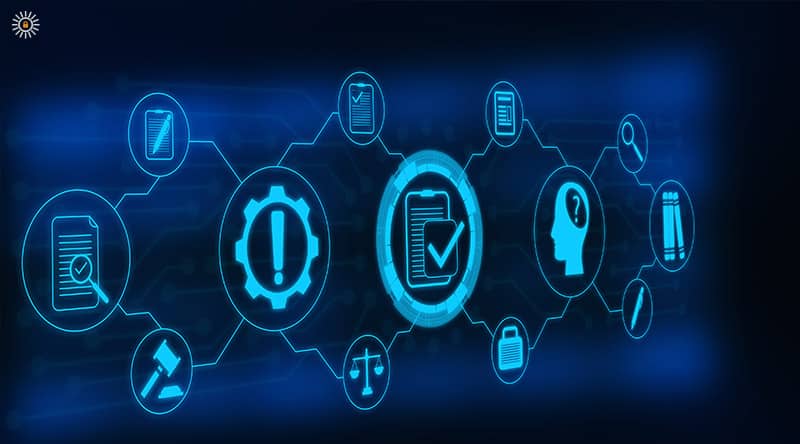- December 7, 2021
- Tags:

A compliance audit is an in-depth examination of an organization’s people, processes, and technologies to verify that regulatory requirements are being met. It promotes accountability and transparency required to foster good governance. Adhering to the standard regulations and protocols is also helpful for maintaining the good health of the organization. Moreover, compliance with local or federal laws is necessary to avoid losses, including penalties (fines) and loss of customer trust. Thus, the compliance audit process protects the organization and its customers.
Furthermore, compliance with regulatory standards is a fundamental element in running a successful business in today’s digital transformation era. The governance, risk, and compliance (GRC) strategies introduced during a compliance audit process helps to align an organization’s risk management goals with the overall business objectives. During a compliance audit process, the type of data that flows through an organization’s infrastructure determines its risk levels and appropriate regulatory standards.
This article will take a deep dive into the structure of compliance audits, their benefits, and how to position an organization to adopt good habits for cost-effective compliance audits.
A Deep Dive into Compliance Audits
The primary function of a compliance audit is to formally review an organization’s procedures and operations to ensure that all applicable standards, laws, rules, and regulations are being followed. The audit report reveals any gaps in compliance while also making recommendations to mitigate any issues.
During an internal compliance audit, an organization checks whether its employees and third-party vendors are aware and adherent to corporate policies, standards, and procedures. Meanwhile, the compliance audit conducted by an external, independent party reviews an organization’s compliance with government- and industry-level regulations associated with its line of business. Most organizations prefer to conduct an internal audit before inviting an external auditor to ascertain its security posture in today’s business world.
According to IBM’s global data breach study, it takes 60–90 days for an organization to realize that a data breach has impacted them. The average cost of mitigating said data breach is around $3.86 million. The security review and gap analysis carried out during a compliance audit help an organization understand the static and dynamic nature of its security architecture and how to manage it without incurring unnecessary costs properly.
Here are the essential benefits of compliance audits:
- First, compliance audits help identify weaknesses and gaps in the regulatory compliance processes to avoid penalties or legal trouble.
- The evaluation helps organizations implement corrective and preventative measures to make necessary changes.
- Compliance with the essential safety standards helps reduce risks and empowers the organization to detect future problems.
- The evaluation shows the avenues for improvement and helps increase business efficiency.
How to Prepare for Compliance Audits
A meeting between the representatives of the organization and the external compliance auditors determines the checklists, guidelines, and scope of the compliance audit. The compliance auditors review all documents, internal controls, and compliance of every department. To assist the auditing process, the C-suite and IT administrators of the organization must provide details of employees joining and leaving the company and those who have access to critical systems.
Aligning the structured approach of GRC with business objectives results in effective risk management and makes the organization compliant with regulations. In addition, GRC software, event log managers, and robust change management software can help organizations prepare for compliance audits.
Good Habits for an Effective Compliance Audit:
- Adhering to deadlines: adhering to strict deadlines is crucial for a successful compliance audit. It proves that an organization is effectively prepared to respond to eventualities associated with the threat landscape.
- Uploading timely documentation and evidence: a complete body of documents and evidence helps compliance auditors determine whether and to what degree organizations are complying with standard regulations. Quickly uploading the necessary documents enables the compliance auditor to inspect evidence for clarification. In addition, buffer time reduces the risk of non-conformities.
- Proactive preparation: A well-designed plan to identify, collect, and manage audit documents and evidence throughout the year makes the whole process a lot easier for the final audit. Creating an audit calendar is an effective way to complete tasks within deadlines and store the results in an organized way to access them easily.
- Frequent internal audits: whereas having an external compliance audit helps boost customer trust and uncover unknown security loopholes, conducting periodic internal audits helps gauge the effectiveness of security controls and the security awareness levels of employees. In addition, with the proper cybersecurity awareness training program, employees are reminded of the importance of complying with the technical, administrative, and physical security controls that contribute to the robust protection of critical business assets.
Conclusion
Many small and mid-size businesses (SMBs) lack the resources to stay abreast with the fast-paced cybersecurity regulatory compliance sector. However, organizations must adopt the good habits described above to consistently maintain a security posture that aligns with existing and future compliance regulations due to the nature of the cybersecurity threat landscape. Although cybersecurity compliance may appear to be mandatory for only more prominent companies, SMBs are also responsible for adhering to relevant compliance frameworks, mainly if personally identifiable information flows through their infrastructure.
Overall, understanding the compliance requirements for your industry is the first step in achieving a robust cybersecurity posture, and compliance audits help ensure that the proper regulatory compliance standards are being implemented. However, is your organization fully equipped to handle the changes associated with industry compliance frameworks, such as HIPAA/HITECH, CMMC, PCI-DSS, NIST 800-53/171, SOC2? Reach out to reputable cybersecurity compliance experts today to ensure that your people, processes, and technologies are adequately positioned to pass both internal and external compliance audits processes.








